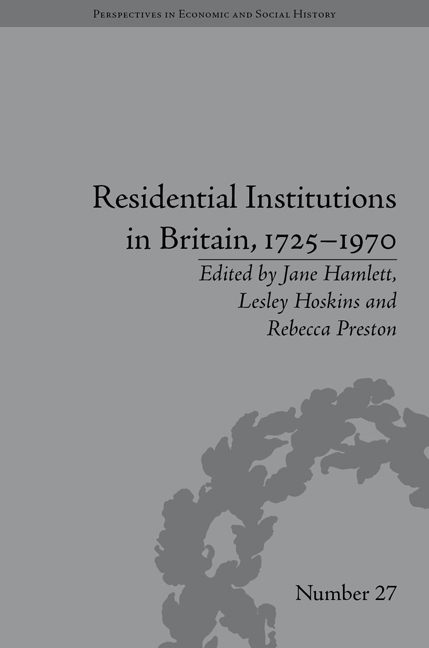Book contents
- Frontmatter
- Contents
- Acknowledgements
- List of Contributors
- List of Figures
- Introduction
- 1 Viewing the Early Twentieth-Century Institutional Interior through the Pages of Living London
- 2 ‘French Beef was Better than Hampstead Beef’: Taste, Treatment and Pauperism in a London Smallpox Hospital, 1871
- 3 From Asylum to Mental Hospital: Gender, Space and the Patient Experience in London County Council Asylums, 1890–1910
- 4 Refuge or Prison? Girls' Experiences of a Home for the ‘Mentally Defective’ in Scotland, 1906–1948
- 5 Paupers and their Experience of a London Workhouse: St Martin-in-the-Fields, 1725–1824
- 6 ‘A Veritable Palace for the Hard-Working Labourer?’ Space, Material Culture and Inmate Experience in London's Rowton Houses, 1892–1918
- 7 ‘The Place was a Home from Home’: Identity and Belonging in the English Cottage Home for Convalescing Psychiatric Patients, 1910–1939
- 8 ‘The Father and Mother of the Place’: Inhabiting London's Public Libraries, 1885–1940
- 9 ‘Discipline with Home-Like Conditions’: The Living Quarters and Daily Life of the Women's Army Auxiliary Corps in First-World-War Britain and France
- 10 Halls of Residence at Britain's Civic Universities, 1870–1970
- Notes
- Index
6 - ‘A Veritable Palace for the Hard-Working Labourer?’ Space, Material Culture and Inmate Experience in London's Rowton Houses, 1892–1918
- Frontmatter
- Contents
- Acknowledgements
- List of Contributors
- List of Figures
- Introduction
- 1 Viewing the Early Twentieth-Century Institutional Interior through the Pages of Living London
- 2 ‘French Beef was Better than Hampstead Beef’: Taste, Treatment and Pauperism in a London Smallpox Hospital, 1871
- 3 From Asylum to Mental Hospital: Gender, Space and the Patient Experience in London County Council Asylums, 1890–1910
- 4 Refuge or Prison? Girls' Experiences of a Home for the ‘Mentally Defective’ in Scotland, 1906–1948
- 5 Paupers and their Experience of a London Workhouse: St Martin-in-the-Fields, 1725–1824
- 6 ‘A Veritable Palace for the Hard-Working Labourer?’ Space, Material Culture and Inmate Experience in London's Rowton Houses, 1892–1918
- 7 ‘The Place was a Home from Home’: Identity and Belonging in the English Cottage Home for Convalescing Psychiatric Patients, 1910–1939
- 8 ‘The Father and Mother of the Place’: Inhabiting London's Public Libraries, 1885–1940
- 9 ‘Discipline with Home-Like Conditions’: The Living Quarters and Daily Life of the Women's Army Auxiliary Corps in First-World-War Britain and France
- 10 Halls of Residence at Britain's Civic Universities, 1870–1970
- Notes
- Index
Summary
Space and Material Culture in a New London Institution for Working Men
In 1898 a journalist writing for London Society reported on a new institution that was attracting attention from the press. Impressed by the ‘imposing structure’ before him, he stepped off the street into Rowton House, King's Cross – where he found ‘a veritable palace for the hard-working labourer’. Rowton Houses were large-scale institutional spaces that housed hundreds of single men in turn-of-the-century London. Lord Rowton, a Tory peer and philanthropist, a nephew of the seventh Earl of Shaftesbury, and formerly Disraeli's private secretary, opened the first Rowton House at Vauxhall in 1892. A lodging house for working men, this enterprise was not solely charitable but was designed to be self-supporting; it was one of a range of semi-philanthropic initiatives that emerged in response to the 1880s' housing crisis in London. The habitations of the urban poor caused a great deal of anxiety, especially common lodging houses, which were thought to harbour criminality and dirt. Rowton had surveyed conditions in common lodging houses in London's East End for the Guinness Trust in about 1890 and he intended Rowton House, Vauxhall, to be a model for accommodating the single working man. Vauxhall's success led to the establishment of Rowton Houses as a limited company that built five, successively larger, Houses at King's Cross (1896), Newington Butts (1897), Hammersmith (1899), Whitechapel (1902) and Camden Town (1905), which alone contained over 1,000 beds.
- Type
- Chapter
- Information
- Residential Institutions in Britain, 1725–1970Inmates and Environments, pp. 93 - 108Publisher: Pickering & ChattoFirst published in: 2014



